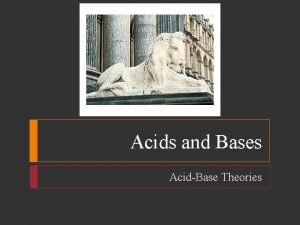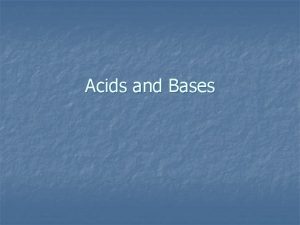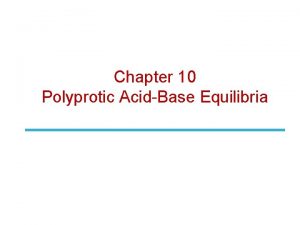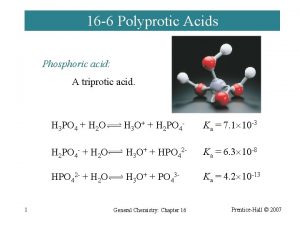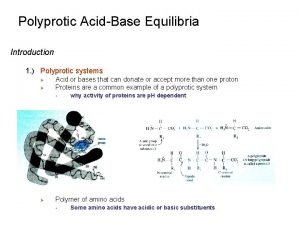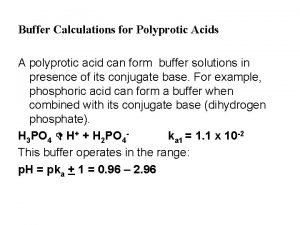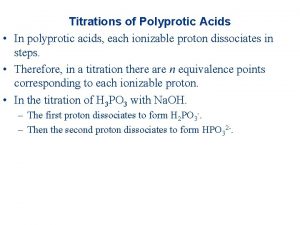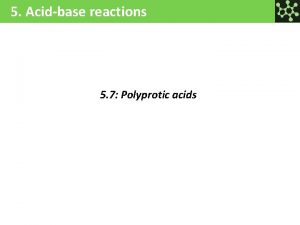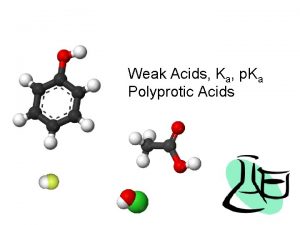p H CALCULATIONS IN POLYPROTIC ACIDS Polyprotic acids
![p. H CALCULATIONS IN POLYPROTIC ACIDS Polyprotic acids have more than one [H+] to p. H CALCULATIONS IN POLYPROTIC ACIDS Polyprotic acids have more than one [H+] to](https://slidetodoc.com/presentation_image/e61c79b3ed67bc502913fc4ce116b56a/image-1.jpg)


![Upper and lower part of this equation multiply with [H+][OH– BUFFER SOLUTIONS Buffer solutions Upper and lower part of this equation multiply with [H+][OH– BUFFER SOLUTIONS Buffer solutions](https://slidetodoc.com/presentation_image/e61c79b3ed67bc502913fc4ce116b56a/image-4.jpg)




- Slides: 8
![p H CALCULATIONS IN POLYPROTIC ACIDS Polyprotic acids have more than one H to p. H CALCULATIONS IN POLYPROTIC ACIDS Polyprotic acids have more than one [H+] to](https://slidetodoc.com/presentation_image/e61c79b3ed67bc502913fc4ce116b56a/image-1.jpg)
p. H CALCULATIONS IN POLYPROTIC ACIDS Polyprotic acids have more than one [H+] to giving the experimental media. p. H Calculations in Strong Polyprotic Acids. H 2 SO 4 is an example to kind of this acids. H 2 SO 4 is ionized in two steps. Because of it’s a strong acid, first ionization is %100. H 2 SO 4 HSO 4 - + H+ Second ionization is; HSO 4 - � H+ + SO 4 -2 Ka = 1. 2 10– 2 and the balance is; For easy calculation, [SO 4 -2] = [HSO 4 - ]. So, [H+] = Ka = 1. 2 10– 2 If we don’t necessary omitting, then, p. H calculations as; [H+]2 – (C – Ka) [H+] – 2 Ka C = 0

p. H Calculations in Weak Polyprotic Acids These kind of acids have more than one H+ to release to experimental media (like H 3 PO 4, H 2 CO 3). Iyonization step number of these acids are related with their H+ number and first ionization is the biggest one when compared with others. For this reason, in p. H calculations, first ionization step is important and other ionization should be omitted. Related to that, formula is; p. H Calculations for Salts of Weak Polyprotic Acids (Polybases) Polybases are salts of weak polyprotic acids structure as Na 2 A and A is an anion of weak acids. Na 2 CO 3 and Na 2 S are example for these. p. H calculations is based on hydrolysis. A 2– from a weak acid hydrolyse water. These kind of salts are formed from combination of weak polyprotic acids and strong bases. For this reason, when these salts are solved in water, p. H is in basic region.

For Na 2 CO 3; This salt is ionized in water as % 100. Na 2 CO 3 2 Na+ + CO 3 -2 This salt is formed from Na. OH and H 2 CO 3 and weak part is CO 3 -2 (A 2–) because H 2 CO 3 is a weak acid and CO 3 -2 hyrolysed water CO 3 -2 + H 2 O � HCO 3 - + OH- Whole of CO 3 -2 are occured from dissolving of Na 2 CO 3 . Decreasing of amount of CO 3 -2 are omitted due to using in hydrolysis. For these reasons, CO 3 -2 = C
![Upper and lower part of this equation multiply with HOH BUFFER SOLUTIONS Buffer solutions Upper and lower part of this equation multiply with [H+][OH– BUFFER SOLUTIONS Buffer solutions](https://slidetodoc.com/presentation_image/e61c79b3ed67bc502913fc4ce116b56a/image-4.jpg)
Upper and lower part of this equation multiply with [H+][OH– BUFFER SOLUTIONS Buffer solutions is a solutions that when a little amount of acids and bases add on it, it’s p. H is not changed and or slightly changed so it resists to p. H change. Buffer solutions can be divided to 2 group. 1) a) A weak acid and salts derived from and a reaction between weak acids and strong bases (For example, CH 3 COOH + CH 3 COONa mixture). This buffer is an acidic buffer because its p. H is in acidic region.

b) A weak bases and salts derived from and a reaction between weak bases and strong acids (For example, NH 4 OH + NH 4 Cl mixture). This buffer is a basic buffer because its p. H is in basic region. 2) Polyprotic acids that partially neutralized and mixture of these (For example; Na. HCO 3 , Na 2 HPO 4 or mixture of Na 2 HPO 4 + Na. H 2 PO 4) Strong acids in media that p. H 3 and strong bases in media that p. H > 11 have buffer characteristic. In a titration curve of HCl with Na. OH, in p. H < 3 and p. H > 11 range, p. H is almost not changed with adding amount of bases so it can be resist to p. H change. The reason of that are activity of solutions and ionic strength of media. Compounds in buffer solutions are converted to each other with adding of acids or bases. Thus, neutralize effects of acids and bases inside and it works as a buffer solutions. For example; when a little amount of acids adding to a buffer solution derived from CH 3 COOH and CH 3 COONa. adding acids is reacted with CH COONa and converted to CH COOH.

In this moment, still a mixture of CH 3 COOH and CH 3 COONa in media. So, further still a buffer pair is in media that react with adding amount of acids and bases. When a little amount of bases adding to a buffer solution derived from CH 3 COOH and CH 3 COONa, adding bases is reacted with CH 3 COOH and converted to CH 3 COONa. In this moment, further still a buffer from CH 3 COOH and CH 3 COONa is exist in media. But, if an amounts of adding acids or bases are higher than amount of compounds in buffer, buffer characteristic is disappeared because of a compound from buffer solution is totally disappeared. p. H Calculations in Buffer Solutions a) In acidic buffers; Acidic buffers are derived from weak acids and their p. H are in acidic region. For example; a buffer derived from CH 3 COOH and CH 3 COONa. In this kind of calculation, two kind of ionization are taken into account.

CH 3 COONa CH 3 COO– + Na+ solvation reaction. CH 3 COOH � CH 3 COO– + H+ balance reaction. And also, ionization of weak acid is used in this calculation. It is accepted that whole of CH 3 COO– ions are derived from solution of CH 3 COONa salts because of % 100 ionization and CH 3 COO– from ionization of CH 3 COOH is existed between other. In this condition, Salt concentration (CH 3 COONa) is used versus concentration of CH 3 COO–. In Ka balance, ıf we calculate –log of it, Henderson- Hasselbach equation is obtained.

Basic buffers: A base that make buffer is weak and p. H of experimental media is in basic range. For example; a buffer derived from NH 4 OH and NH 4 Cl. In this kind of calculation, two kind of ionization are taken into account. NH 4 Cl NH 4+ + Cl solvation reaction. NH 4 OH � NH 4+ + OH- balance reaction. And also, ionization of weak acid is used in this calculation. It is accepted that whole of NH 4+ ions are derived from solution of NH 4 Cl salts because of % 100 ionization and NH 4+ from ionization of NH 4 OH is existed between other. In this condition, Salt concentration (NH 4 Cl) is used versus concentration of. In Kb balance, if we calculate –log of it, Henderson- Hasselbach equation is obtained. (p. Kb = – log Kb)
